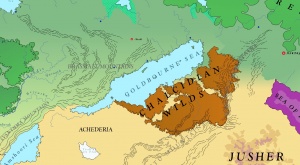Difference between revisions of "Chrysopolite Sea"
Trismegistus (talk | contribs) (Created page with "thumb|300px|The Goldbourne Sea rests between the [[Idrakanian Mountains and the Chalcidian Wilds.]] The Chrysopolite Sea is the second large...") |
Trismegistus (talk | contribs) m |
||
| Line 1: | Line 1: | ||
| − | [[File:MapGoldbourneSea.jpg|thumb|300px|The | + | [[File:MapGoldbourneSea.jpg|thumb|300px|The Chrysopolite Sea rests between the [[Idrakanian Mountains]] and the [[Chalcidian Wilds]].]] |
The Chrysopolite Sea is the second largest inland sea after the [[Sea of a Thousand Curses]]. The sea is nearly one third the saltiness of the ocean with very deep channels towards its center. The sea is called 'chrysopolite' because early travelers noted small glints of yellow metal along its coasts which they thought were gold. They are in fact a type of fauna that is unique to the Chrysopolite Sea which has a metallic brownish-orange color. At some times when these tiny creatures are spawning, they form great, dimly glowing masses of orangish-yellow in the shallows along the coasts. The sea is surrounded by wildlands and is accessible only by caravans and specially prepared travelers. Scholars posit a relationship between the sea and the [[Chalcidian Wilds]], but have not come to any consensus. | The Chrysopolite Sea is the second largest inland sea after the [[Sea of a Thousand Curses]]. The sea is nearly one third the saltiness of the ocean with very deep channels towards its center. The sea is called 'chrysopolite' because early travelers noted small glints of yellow metal along its coasts which they thought were gold. They are in fact a type of fauna that is unique to the Chrysopolite Sea which has a metallic brownish-orange color. At some times when these tiny creatures are spawning, they form great, dimly glowing masses of orangish-yellow in the shallows along the coasts. The sea is surrounded by wildlands and is accessible only by caravans and specially prepared travelers. Scholars posit a relationship between the sea and the [[Chalcidian Wilds]], but have not come to any consensus. | ||
Latest revision as of 14:44, 24 September 2023
The Chrysopolite Sea is the second largest inland sea after the Sea of a Thousand Curses. The sea is nearly one third the saltiness of the ocean with very deep channels towards its center. The sea is called 'chrysopolite' because early travelers noted small glints of yellow metal along its coasts which they thought were gold. They are in fact a type of fauna that is unique to the Chrysopolite Sea which has a metallic brownish-orange color. At some times when these tiny creatures are spawning, they form great, dimly glowing masses of orangish-yellow in the shallows along the coasts. The sea is surrounded by wildlands and is accessible only by caravans and specially prepared travelers. Scholars posit a relationship between the sea and the Chalcidian Wilds, but have not come to any consensus.
The Chrysopolite Sea rests between the Idrakanian Mountains to the northwest and the Chalcidian Wilds to the southeast. A long tongue of the sea reaches from it to the southwest and forms the northern border of Achederia. There are several islands in the sea.
The hullness of Tokorinar floats over the southwestern tongue of the Chrysopolite Sea.
See Also
| This article is a stub. It requires further development by the creator. |
